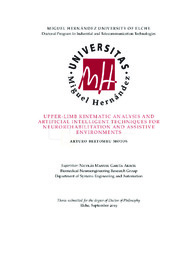Please use this identifier to cite or link to this item:
https://hdl.handle.net/11000/8215Upper-limb Kinematic Analysis and Artificial Intelligent Techniques for Neurorehabilitation and Assistive Environments
| Title: Upper-limb Kinematic Analysis and Artificial Intelligent Techniques for Neurorehabilitation and Assistive Environments |
| Authors: Bertomeu Motos, Arturo |
| Tutor: García Aracil, Nicolás Manuel |
| Department: Departamentos de la UMH::Ingeniería de Sistemas y Automática |
| Issue Date: 2019-11-15 |
| URI: http://hdl.handle.net/11000/8215 |
| Abstract: Stroke, one of the leading causes of death and disability around the world, usually affects the motor cortex causing weakness or paralysis in the limbs of one side of the body. Research efforts in neurorehabilitation technology have focused on the development of robotic devices to restore motor and cognitive function in impaired individuals, having the potential to deliver high-intensity and motivating therapy. End-effector-based devices have become an usual tool in the upper- limb neurorehabilitation due to the ease of adapting to patients. However, they are unable to measure the joint movements during the exercise. Thus, the first part of this thesis is focused on the development of a kinematic reconstruction algorithm that can be used in a real rehabilitation environment, without disturbing the normal patient-clinician interaction. On the basis of the algorithm found in the literature that presents some instabilities, a new algorithm is developed. The proposed algorithm is the first one able to online estimate not only the upper-limb joints, but also the trunk compensation using only two non-invasive wearable devices, placed onto the shoulder and upper arm of the patient. This new tool will allow the therapist to perform a comprehensive assessment combining the range of movement with clinical assessment scales. Knowing that the intensity of the therapy improves the outcomes of neurorehabilitation, a ‘self-managed’ rehabilitation system can allow the patients to continue the rehabilitation at home. This thesis proposes a system to online measure a set of upper-limb rehabilitation gestures, and intelligently evaluates the quality of the exercise performed by the patients. The assessment is performed through the study of the performed movement as a whole as well as evaluating each joint independently. The first results are promising and suggest that this system can became a a new tool to complement the clinical therapy at home and improve the rehabilitation outcomes. Finally, severe motor condition can remain after rehabilitation process. Thus, a technology solution for these patients and people with severe motor disabilities is proposed. An intelligent environmental control interface is developed with the ability to adapt its scan control to the residual capabilities of the user. Furthermore, the system estimates the intention of the user from the environmental information and the behavior of the user, helping in the navigation through the interface, improving its independence at home. El accidente cerebrovascular o ictus es una de las causas principales de muerte y discapacidad a nivel mundial. Normalmente afecta a la corteza motora causando debilidad o parálisis en las articulaciones del mismo lado del cuerpo. Los esfuerzos de investigación dentro de la tecnología de neurorehabilitación se han centrado en el desarrollo de dispositivos robóticos para restaurar las funciones motoras y cognitivas en las personas con esta discapacidad, teniendo un gran potencial para ofrecer una terapia de alta intensidad y motivadora. Los dispositivos basados en efector final se han convertido en una herramienta habitual en la neurorehabilitación de miembro superior ya que es muy sencillo adaptarlo a los pacientes. Sin embargo, éstos no son capaces de medir los movimientos articulares durante la realización del ejercicio. Por tanto, la primera parte de esta tesis se centra en el desarrollo de un algoritmo de reconstrucción cinemática que pueda ser usado en un entorno de rehabilitación real, sin perjudicar a la interacción normal entre el paciente y el clínico. Partiendo de la base que propone el algoritmo encontrado en la literatura, el cual presenta algunas inestabilidades, se ha desarrollado un nuevo algoritmo. El algoritmo propuesto es el primero capaz de estimar en tiempo real no sólo las articulaciones del miembro superior, sino también la compensación del tronco usando solamente dos dispositivos no invasivos y portátiles, colocados sobre el hombro y el brazo del paciente. Esta nueva herramienta permite al terapeuta realizar una valoración más exhaustiva combinando el rango de movimiento con las escalas de valoración clínicas. Sabiendo que la intensidad de la terapia mejora los resultados de la recuperación del ictus, un sistema de rehabilitación ‘auto-gestionado’ permite a los pacientes continuar con la rehabilitación en casa. Esta tesis propone un sistema para medir en tiempo real un conjunto de gestos de miembro superior y evaluar de manera inteligente la calidad del ejercicio realizado por el paciente. La valoración se hace a través del estudio del movimiento ejecutado en su conjunto, así como evaluando cada articulación independientemente. Los primeros resultados son prometedores y apuntan a que este sistema puede convertirse en una nueva herramienta para complementar la terapia clínica en casa y mejorar los resultados de la rehabilitación. Finalmente, después del proceso de rehabilitación pueden quedar secuelas motoras graves. Por este motivo, se propone una solución tecnológica para estas personas y para personas con discapacidades motoras severas. Así, se ha desarrollado una interfaz de control de entorno inteligente capaz de adaptar su control a las capacidades residuales del usuario. Además, el sistema estima la intención del usuario a partir de la información del entorno y el comportamiento del usuario, ayudando en la navegación a través de la interfaz, mejorando su independencia en el hogar. |
| Keywords/Subjects: Tecnología médica Robótica Inteligencia artificial |
| Knowledge area: CDU: Ciencias aplicadas: Ingeniería. Tecnología |
| Type of document: application/pdf |
| Access rights: info:eu-repo/semantics/openAccess |
| Appears in Collections: Tesis doctorales - Ciencias e Ingenierías |
.png)

